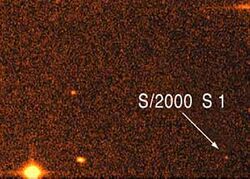Astronomy:Ymir (moon)
 Discovery image of Ymir taken by the La Silla Observatory in August 2000 | |
| Discovery[1] | |
|---|---|
| Discovered by | Brett J. Gladman |
| Discovery site | Observatoire de la Cote d'Azur |
| Discovery date | 2000 |
| Designations | |
Designation | Saturn XIX |
| Pronunciation | /ˈiːmɪər/,[2] /ˈɪmɪər/[3] |
| Named after | Ymir |
| S/2000 S 1 | |
| Adjectives | Ymirian /ɪˈmɪəriən/[4][5] |
| Orbital characteristics[6] | |
| 23,040,000 km | |
| Eccentricity | 0.3349 |
| Orbital period | 3.6 yr (1315.14 d) |
| Mean anomaly | 244.521° |
| Inclination | 173.125° |
| Longitude of ascending node | 194.086° |
| 22.668° | |
| Satellite of | Saturn |
| Group | Norse group |
| Physical characteristics | |
| Mean diameter | 19+50% −30% km[7] |
| Rotation period | 11.92220±0.00002 h[7] 11 h 55 m 20 s[8] |
| Albedo | 0.06[9] |
Spectral type | D/P[8] |
Ymir /ˈiːmɪər/, or Saturn XIX, is the second-largest retrograde irregular moon of Saturn. It was discovered by Brett J. Gladman, et al. in 2000, and given the temporary designation S/2000 S 1. It was named in August 2003 after Ymir, who in Norse mythology is the ancestor of all the Jotuns or frost giants.[10]
It takes 3.6 Earth years to complete an orbit around Saturn. Of the moons that take more than 3 Earth years to orbit Saturn, Ymir is the largest, at about 18 kilometres (11 miles) in diameter;[11] Ymir is also the second largest member of the Norse group, after Phoebe.[8]
Spectral measurements from Cassini–Huygens show that Ymir is reddish in color, unlike Phoebe's gray color, suggesting a separate origin for this moon.[8] It shows a similar light curve as Siarnaq and has a triangular shape, rotating in a retrograde direction about once every 11.9 hours.[8]
References
- ↑ Brian G. Marsden (2000-10-25). "IAUC 7512". IAU. http://www.cbat.eps.harvard.edu/iauc/07500/07512.html.
- ↑ "Ymir". Merriam-Webster Dictionary. https://www.merriam-webster.com/dictionary/Ymir.
- ↑ Merriam-Webster's Encyclopedia of Literature. 1995.
- ↑ Budd (1898). "Norse Mythology". St. Mary's Hall lectures: and other papers. p. 84. Because the -r is an inflectional ending, and the oblique stem is Ymi (as in Modern Norse Yme), one might expect the English adjective to be ?Ymian, but that is perhaps too short a word to be easily intelligible.
- ↑ James Hall III (2015). Moons of the Solar System. p. 107.
- ↑ Jacobson, R.A. (2007) SAT270, SAT271 (2007-06-28). "Planetary Satellite Mean Orbital Parameters". JPL/NASA. http://ssd.jpl.nasa.gov/?sat_elem#saturn.
- ↑ 7.0 7.1 Denk, T.; Mottola, S. (2019). "Cassini Observations of Saturn's Irregular Moons". 50th Lunar and Planetary Science Conference. Lunar and Planetary Institute. https://www.hou.usra.edu/meetings/lpsc2019/pdf/2654.pdf.
- ↑ 8.0 8.1 8.2 8.3 8.4 T. Denk, S. Mottola, F. Tosi, W.F. Bottke, D.P. Hamilton (2018). The Irregular Satellites of Saturn. Space Science Series, The University of Arizona Press, Tucson, AZ. Chapter 20. 409–434. doi:10.2458/azu_uapress_9780816537075-ch020. ISBN 9780816537075. Bibcode: 2018eims.book..409D. https://tilmanndenk.de/wp-content/uploads/DenkEtAl2018_IrregularMoons.pdf.
- ↑ Nicholson, P. D. 2001
- ↑ Daniel W. E. Green (2003-08-08). "IAUC 8177: Sats OF (22); Sats OF JUPITER, SATURN, URANUS". IAU. http://www.cbat.eps.harvard.edu/iauc/08100/08177.html.
- ↑ Cite error: Invalid
<ref>tag; no text was provided for refs namedsheppard
External links
- MPEC 2000-Y15: S/2000 S 1, S/2000 S 2, S/2000 S 7, S/2000 S 8, S/2000 S 9 (2000 Dec. 19 ephemeris)
- Ephemeris IAU-NSES
- Saturn's Known Satellites (by Scott S. Sheppard)
- Ymir website (by Tilmann Denk)
 |




